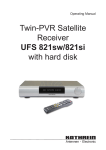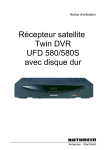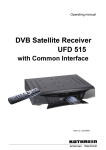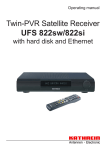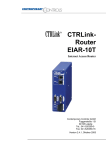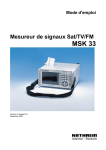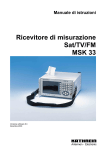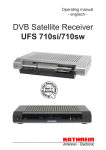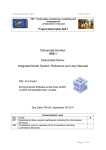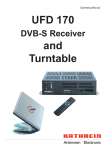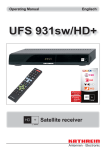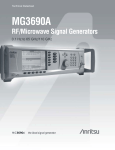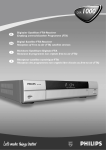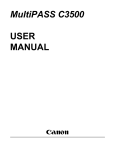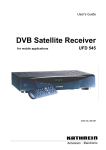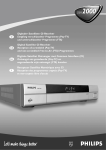Download Kathrein UFD 580S User's Manual
Transcript
Operating Manual Twin-DVR Sat Receiver UFD 580/580S with Hard Disk Drive Preface Preface Dear customer, This Operating Manual is intended to help you make the fullest use of the extensive range of functions offered by your new satellite receiver. We have tried to make the operating instructions as easy as possible to understand, and to keep them as concise as possible. To help you understand particular specialist terms that cannot be translated, we have added a short glossary at the end of the manual. The power switch is an environmentally friendly feature. If you will not be using your receiver for a longer period, you should therefore use the power switch to disconnect it from the power supply to save energy. For shorter breaks, you can switch the receiver to standby on the remote control, which uses only a minimal amount of energy. We wish you good reception and much pleasure using your new DVR-Sat receiver. Your KATHREIN Team Important Information If you should experience any unexpected problems with your receiver, please contact your specialist dealer or our hotline: Tel.: +49 8031 184-700 Fax: +49 8031 184-676 The programmes available on the satellites and transponders are subject to continual change. In such cases, it is necessary to reset the channels as the factory preset programming corresponds to the situation on the date of manufacture. The information for this reset can be found on the SAT 1 Videotext/Teletext service, on the Internet or in TV and radio magazines. Your receiver is factory fitted with the latest software version. We are, however, constantly working on adapting the software to the wishes of our customers and to developments in technology. The “Software and Channel List Update” section contains additional information. Please keep the original packaging in case you need to return the product at any time. The hard disks are fragile due to their construction and are only adequately protected in the receiver by the original packaging. If receiver is not shipped correctly the warranty on the hard disk will be voided. ® ® UFO micro and UFO mini are registered trademarks of KATHREIN-Werke KG. DiSEqC™ is a trademark of Eutelsat. Contents Contents Preface...............................................................................................................................................................2 Contents ............................................................................................................................................................3 Safety Instructions - Important Information...................................................................................................6 Receiver-Features.............................................................................................................................................7 Remote control RC 660 7 Remote Control Menu Functions ....................................................................................................................8 Controls, Displays und Connections..............................................................................................................9 View of front panel (flap folded down) 9 View of rear panel 9 Front Panel Controls and Displays 9 Rear Panel Controls and Displays 9 Important Note on Initial Operation of the Receiver on a UFO®micro System.........................................10 Operating Instructions ...................................................................................................................................11 Menu Concept 11 Alphanumeric Inputs 11 Alphanumeric Assignment of Remote Control Number Buttons 12 Language Selection - OSD 12 Connection and Setup....................................................................................................................................13 Connecting the Unit 13 Sat IF Connection 13 Reception Requirements 13 Reception System Presets 13 Operation on one Antenna Connection 14 TV and Video Recorder Connection 15 Audio Connection 15 SPDIF Connections (Electrical/Optical) 15 Inserting Batteries in the Remote Control 15 Initial Setup .....................................................................................................................................................16 Getting Started 16 Power Failure Safety 16 Error Signalling 16 Receiver Presetting 17 On Screen Display (OSD)...............................................................................................................................18 Important On-Screen Displays 18 Help Function 18 TV Channel Identifier 19 Radio Channel Identifier 19 Error Signalling 19 TV/Radio Channel List 20 Videotext (Teletext).........................................................................................................................................21 Channel List ....................................................................................................................................................22 Selecting a TV Programme 22 Reception Status 22 Selecting a TV Programme by Number 23 Switching to a Radio Programme 24 Common Interface ..........................................................................................................................................25 Tein Functions ................................................................................................................................................27 Picture-in-Picture (PIP) 27 Time-Shift 28 One-Touch Recording 28 TVTV EPG and Timer......................................................................................................................................29 Accessing the TVTV EPG for the First Time 29 Accessing the TVTV EPG 30 “Current” View 30 3 Contents Programme List Highlights Programmes Sorted by Category Search Function Details Programming a Recording Timer List Key to Symbols Channel List 31 32 32 33 34 35 37 40 41 Hard Disk Recorder ........................................................................................................................................42 Recording and Watching TV 42 LNB Configuration - Overview 42 Tuner input 42 Recording 43 Hard Disk Capacity 43 Time-Shift Recording 44 One-Touch Recording (OTR) 45 Timer Recording 46 Stopping a Recording 46 Split Take 48 Playback and Recording 48 Fast Forward/Fast Rewind (no picture) 49 Playback 49 Audio Mode 52 Search 52 Delete 52 Audio Settings ................................................................................................................................................53 Setting the Volume 53 Muting 53 Stereo and Two-Channel Sound Playback 53 AC 3 53 Programme List ..............................................................................................................................................54 Favourites 54 Generating a Favourites List 55 Alphabetical Channel Search 56 Sorting Programmes 58 Deleting Programmes 59 Manually Adding Programmes 59 Selecting the Last Programmes Received 61 Password.........................................................................................................................................................62 Factory Default 62 Entering the Password 62 Parental Control 64 Using the Front Panel.....................................................................................................................................66 Backup Operation 66 Setting System Parameters ...........................................................................................................................67 System Parameters 68 Parental Control 68 System Information 68 Local Time/Timer 68 TV Type 69 Aspect Ratio 69 Screen 69 A/V Mode 69 Adding/Removing Satellites ..........................................................................................................................70 Satellite Setup 70 Entering a Satellite Name 71 Removing Satellites 71 4 Contents Installation Menu ............................................................................................................................................72 LNB Configuration 72 Antenna Setup 75 Antenna Rotor/Positioner (DiSEqC™1.2) 75 Satellite Scan 76 TP Edit/Scan 77 Important Note on Deleting Transponders 79 DiSEqC™ [UFO] Setup 80 UFO®micro 82 Factory Set 82 Logging on to UFOmicro® 82 Video Recorder Connection ..........................................................................................................................83 Recording 83 Playback 83 Software and Programme List Update .........................................................................................................84 Receiver to Receiver Data Transfer ..............................................................................................................86 Preparations 86 Programme List Download 86 Operating System Software Download 86 Technical Appendix........................................................................................................................................87 Technical Features 87 Technical Data 88 Connections 89 Accessories 90 Scart Socket Assignment 90 VHS/S-VHS Switching 90 Connection Example 91 Troubleshooting .............................................................................................................................................92 Short Technical Guide....................................................................................................................................93 Service .............................................................................................................................................................96 5 Safety Instructions - Important Information Safety Instructions - Important Information 6 Receiver-Features Receiver-Features The UFD 580 has two separate tuners for simultaneous reception of two programmes, and a hard disk for recording and playback. Depending on constellation, you can • view one programme and record another to hard disk, • play back one programme from the hard disk and record one programme to hard disk, or • record two programmes to hard disk and play back one programme from the hard disk, or • record two programmes to hard disk and view a programme from one of the programme packages being received. To take advantage of all these opportunities, complex operating procedures are necessary. You should therefore read this operating manual thoroughly. Remote control RC 660 The RC 660 remote control supports up to four devices as well as the receivers of the UFD 5xx (not UFD 552, 554, 558) and UFD 4xx families. To configure a receiver to an infrared code: Switch on the relevant receiver. On the remote control simultaneously press Address 1 = ++ to Address 4 = ++ To configure the remote control to an infrared code: Switch to Address 1 = + to Address 4.= + + (red) = Kathrein UFD 5xx code for remote control RC 400 The RC 600 and RC 650 remote controls cannot be replaced! 7 Remote Control Menu Functions Remote Control Menu Functions Sound on/off ... Number input for programmes, timer etc. Power on/off Videotext/Teletext Tone selection Menu Prog; Make channel favourite picture-in-picture from 2nd tuner or from hard disk Lock channel Volume Programme info AV mode Programm selection up/down Exit menu Confirm input Arrow buttons Rewind Play back hard disk content Freeze frame, video timeshift Recording Slow-motion during playback 8 Switch TV/Radio Electronic Programme Guide Fast forward Stop recording/playback TV freeze frame Controls, Displays und Connections Controls, Displays und Connections This section provides a brief description of all the controls, displays and connections. The button symbols presented here can also be found in the description of the operating steps. View of front panel (flap folded down) 1 2 3 4 5 6 7 6 7 8 9 10 View of rear panel 1 2 3 4 5 Front Panel Controls and Displays 8 9 10 11 Rear Panel Controls and Displays 1 On/Off switch (with mains disconnect) 1 LNB 1 input and loop-through output 2 Menu button to call up or exit menus or submenus 2 LNB 2 input and loop-through output 3 3 Remote control signal acknowledge 4 Select button to confirm a selection Optical data stream output (SPDIF/Sony Philips Digital Interchange Format) for Dolby Digital AC 3 audio 5 Operation indicator 4 USB port (for Service only) 6 Standby indicator 5 Electrical SPDIF data stream output (AC 3) audio 7 Arrow buttons for menu and programme list 6 Scart socket for VCR-/AUX connection 8 LED (4-digit, 7-segment display) to show programme slot and time, Play and Record 7 Scart socket for TV connection 9 Common interface for Pay TV cards*) 8 Audio outputs (L/R) cinch sockets 9 Video output (FBAS) 10 Pressure catch for front flap. Open by lightly applying pressure on the upper right-hand side *) CA modules and Pay TV cards are not included 10 RS 232 port (for Service only) 11 Mains power cable 9 Important Note on Initial Operation of the Receiver on a UFO®micro System Important Note on Initial Operation of the Receiver on a UFO®micro System It is absolutely essential to carry out the following before and while registering receivers on the EXU 544 UFO®micro single-cable matrix: - Connect the receiver to the TV set, but do not yet connect it to the UFO®micro ESU 32 outlet! - You must first check the following settings on the “LNB Configuration” menu and change them as necessary: button to switch to the main menu Press to get to the installation menu and confirm your entry by pressing Press to get to the LNB configuration menu and confirm your entry by pressing Press to select the “ASTRA” satellite and confirm your entry by pressing Press to select “Tuner input” and press to change the selection to "#1 & #2“ Press to quit the set-up for the “ASTRA” satellite 1. Press the 2. 3. 4. 5. 6. You must run through steps 4-6 for each satellite received! - three times to get back to the start screen 7. Press 8. Interconnect the “LNB1 LOOP OUT” tuner output and the “LNB2 IN” tuner input by a coaxial cable (F standard connector). Now carry out a UFO®micro reset on the receiver, as described below: button to switch to the main menu 2. Press to get to the installation menu and confirm your entry by pressing 3. Press to get to the DiSEqC[UFO] set-up and confirm your entry by pressing 4. Press to select the UFO option 5. On the UFO menu press to select “UFO micro” 6. Press and change your selection to RESET by pressing Confirm your selection by pressing 7. Press to quit the UFO menu (press to save your changes) 8. Press three times to get back to the starting point Press to switch the receiver to standby mode 1. Press the ® - Now you can connect the receiver to the ESU 32 outlet - to switch the receiver on Press The registration is then performed automatically – the screen briefly shows: “UFO®micro active” Now perform a UFO®micro reset as described above (items 1-8). 10 Operating Instructions Operating Instructions Menu Concept The structure of the menu concept is based on logical operating sequences. The current selected programme always appears in the upper righthand corner of the screen. Note: The selected menus, sub-menus and positions, as well as the parameters to be set, are each highlighted in colour. The menus are self-explanatory to a great extent. For additional information, press the button (See “On-screen display/Help function”). Pay attention to the bar at the bottom of the on-screen display! It provides guidance on what to do next. The main menu is opened by pressing the button and the sub- buttons. To access the submenus, press . The items in the submenus are selected by pressing the buttons. menus are selected using the The settings under the various options are made either by pressing buttons or using the number pad. Quit the main menu or submenus by pressing . the Alphanumeric Inputs Pay attention to the bar at the bottom of the screen with details on the relevant menu item! You use the number pad buttons to enter programme and satellite names. The numbers and letters appear in the name fields of the corresponding menus. Place the cursor in the name field. The first character is automatically given a dark background. You can now use the number pad to enter letters by pressing the relevant button several times. For example, the “2” is also used for A, B and C. 11 Operating Instructions Alphanumeric Assignment of Remote Control Number Buttons Button 1x 2x 3x 4x 5x 1 . , ? 1 2 A B S 2 3 D E F 3 4 G H I 4 5 J K L 5 6 M N O 6 7 P/Q R S 7 8 T U V 8 9 W X Y Z 0 UNUSED 0 UNUSED 0 Language Selection - OSD The language for the on-screen display is set as follows: ➙ ➙ Menu language ➙ ➙ English ➙ The languages available are Dutch, English, French, German, Italian, Portuguese, Spanish and Turkish. 12 Connection and Setup Connection and Setup The following section is intended specifically for specialist dealers. You only need to pay attention to this section if you are carrying out the installation yourself. The “Connection Examples” section provides a range of sample configurations. Do not connect the unit to the mains until all installation work has been properly carried out. Refer to the information in the “Safety instructions” section. Connecting the Unit Sat IF Connection Connect the Sat IF inputs on the receiver to the satellite reception system. Use coaxial cable with a standard F connector. If the F connectors are not yet fitted on the cable, strip the insulation from the cables as shown in the following illustration and carefully twist the F connectors onto the ends of the cables until they are securely fitted. When fitting the connector, make sure that no wires from the braiding are touching the inner conductor, so no short circuit can occur. The quality of the reception signal depends on the connection. Reception Requirements Make sure that your own satellite antenna system is equipped at least with a universal LNB for digital reception in the high-band range. Reception System Presets The presets for the control signals have been made for standard reception systems, i.e. 14/18 V for polarity reversal and 22 kHz switching signal for low/high band changeover on multi-feed reception systems. The preset will need to be changed in the installation menu under “DiSEqC™” if UFO®micro or tone burst switching matrices are used in the receiving system. Refer to the section headed “Installation menu, DiSEqC™ menu”. Be sure to follow the operating instructions for the matrix used. 13 Connection and Setup Operation on one Antenna Connection To enable you to utilise all the reception and recording properties of your UFD 580 twin-DVR Sat receiver, such as 1. recording one programme and at the same time viewing any other programme or zapping through the programmes, and 2. recording two different programmes at the same time, the two tuner inputs of the Sat receiver must each be supplied with a dedicated satellite signal from the antenna system/Sat outlet. The receiver tuner inputs are factory preset on the installation menu for “#1 & #2” mode, meaning for two separate Sat antennas. Coax cable with F connectors If you only have one antenna connection available, we recommend you interconnect the output of tuner 1 and the input of tuner 2 by a coaxial cable with F connectors. Then “Loop” mode must be selected on the installation menu for the tuner input. You will find the “Tuner input” option by pressing the button. Then select “Installation”, “LNB configuration”, and confirm the satellite you are receiving by pressing . You can then make the settings here, though a restriction on this is that with tuner 2 you can only receive the additional programmes of the plane currently set by tuner 1 (e.g. Horizontal High). Note: This will only work when receiving one satellite, not in multifeed reception! If only tuner 1 is connected (with no connection to tuner 2), the setting “#1” must be selected for the tuner input. You can then have only the possibilities offered by a normal “single” receiver available to you. If this setting is not made, malfunctions will occur and the following message will be displayed: Weak signal or no signal! 14 Connection and Setup TV and Video Recorder Connection Connect the satellite receiver (TV Scart socket) and the TV set by a Scart cable (see “Connection example”). If your TV has a stereo feature, you can receive the sound in stereo via the Scart connection. Connect the satellite receiver (VCR/AUX Scart socket) and the video recorder likewise by a Scart cable. For system reasons, the same video signals are to be found on the Scart outputs and on the video cinch output. If you are recording using an external video recorder, remember not to operate the receiver during recording, otherwise all the on-screen displays will appear on your recording. Audio Connection If you want to play the sound on your hi-fi system, connect the audio cinch sockets to the input sockets on the hi-fi system with an appropriate cable (see “Connection example”). SPDIF Connections (Electrical/Optical) The electrical SPDIF cinch output and the optical output are for connection to a Dolby digital system (see “Connection example”). Inserting Batteries in the Remote Control Remove the cover on the rear of the remote control. Insert the two supplied batteries into the remote control. Ensure correct polarity of the batteries; the + and – markings are indicated inside the battery compartment. Slide the cover back into the housing until it locks in place. Used batteries are special waste. Do not throw used batteries into your household waste; take them to a collection point for old batteries. Electronic equipment is not household waste - in accordance with directive 2002/96/EC OF THE EUROPEAN PARLIAMENT AND THE th COUNCIL dated 27 January 2003 on used electrical and electronic equipment, it must be disposed of properly. At the end of its service life, take this unit for disposal at a designated public collection point. 15 Initial Setup Initial Setup Getting Started Connect the unit to the mains power supply. Switch on the receiver by pressing the power button on the front of the unit. The LED shows “- - - - ”. The operation indicator LED lights up red, the unit is in standby. Switch on the receiver by pressing the control. button on the remote The red LED on the front panel of the receiver flashes each time a button on the remote control is pressed. The screen displays the factory preset programme. In the bottom section of the screen is an information bar showing the name of the programme provider, the time, the timer settings, the programme status and title, provided those details are being broadcast. The LED display indicates the programme's memory location number. The red standby indicator goes out. You can now receive the factory preset TV and radio programmes and buttons. Press (blue) and to select radio programmes. Press the blue button again to return to the TV call them up by pressing the programmes. For details of how to save additional TV and radio programmes, refer to the "TV/Radio Programme Lists" section. Please check the time is correct according to whether you are on Summer or Winter time. When you switch on, the last reception status set is always restored. Power Failure Safety After a power failure, the receiver automatically powers up, obtains the time from the reception signal and then returns to standby. This preserves the timer settings. Error Signalling If the message “Weak signal or no signal” appears on the screen as well as the display for the last programme received, check the installation of the system and/or the receiver settings. If this only affects individual programme slots, there may be an interrupted signal from the programme provider or a fault in the reception system (cable or satellite system). First of all, check the connection configuration and whether the default receiver settings are correct for your system. In case of doubt, consult a specialist engineer. 16 Initial Setup Receiver Presetting Your receiver is factory pre-programmed to receive the ASTRA (19° East/28°East) and HotBird satellites, as well as Eutelsat 10E and 16E, TurkSat 42E, Telecom 5W and 8W, and others. You do not normally need to make any additional settings. If you are not connected to a communal system, you will need a multifeed arrangement with at least two LNBs in front of the satellite dish in order to receive multiple satellite systems. Consult your specialist dealer on this. Before you change the basic settings of your receiver, write down the settings on the form provided at the end of this operating manual. You will then be able to restore the original settings at any time. 17 On Screen Display (OSD) On Screen Display (OSD) Important On-Screen Displays The receiver functions are controlled by a microprocessor and comprehensive software. The following explanations are intended to improve your understanding of all procedures and to minimise the risk of mistakes. Help Function You can call up help for each menu or menu function. This help function provides you with a brief description of the most important functions of the selected menu options. For example, access the main menu by pressing . You can now view the help display for the “Installation” option by pressing . Pay attention to the bar at the bottom of the on-screen display! It provides guidance on what to do next. You will find detailed descriptions of the selected menu items in the relevant sections of the operating manual. 18 On Screen Display (OSD) Press to quit the help function and return to the main menu. Press again to return to the original programme you were receiving. TV Channel Identifier The channel identifier is displayed for a few seconds each time you change the programme or constantly if you press the button. The i indicates that a channel is being received even if no picture can be seen (e.g. radio). The TV symbol indicates a TV channel - adjacent to it is the selected programme, whether Videotext/Teletext is being received, and the current time. The + on the third line indicates the programme selection from the master list. If the Favourites list is selected, the “apple” symbol appears here. This is followed by the programme title, the start and end time of the current programme, and the next programme, if this data is being transmitted. Radio Channel Identifier The message for the set radio channel has the same layout. A radio receiver symbol in the top left-hand corner indicates that it is a radio channel. Error Signalling “Weak signal or no signal” indicates that an error has occurred in the reception system or in the receiver settings, or that the transponder is not sending. The channel identifier shows a satellite antenna instead of the i. Check the Sat IF connection and the LNB configuration. The list of service settings at the end of this manual can be used to help you do this. 19 On Screen Display (OSD) TV/Radio Channel List Press the button to access the channel list. At the top left is a + for the complete list. Information about the channel, the programme provider, and whether the programme is currently encrypted, is shown in the column underneath. In the upper right-hand column are details of the satellites received, the transponder and its frequency, and the polarisation. The desired programme can be chosen using the bar cursor or by entering the relevant number and is then confirmed by pressing . In the bottom right-hand corner you will find the “Programme/Channel Settings” menu. The factory settings for programmes and channels can be changed here. Press the button (red) to save the channel shown as a favourite channel button (green) to lock the displayed channel button (yellow) to move the channel to another position button (blue) to delete the displayed channel from a position Press to add a new channel Press to select the programme mode of the programme list. Always follow further instructions or press to quit. For more information refer to the “Programme Selection” section. 20 Videotext (Teletext) Videotext (Teletext) This symbol in the programme display shows you whether Videotext/Teletext is broadcast for the selected programme. button, the receiver processes the broadcast When you press the Videotext/Teletext service for your TV set to display, even when the signal is encrypted. During the search, the programme page (here P100) which is being searched for is displayed in the top left-hand corner, and the permanent time display is shown at the top right. When the search is finished, the Videotext/Teletext being broadcast by the relevant programme provider appears: The individual pages can then be opened using the number buttons. During the search, a white star flashes in the top left-hand corner of the screen. Press or to exit the Videotext/Teletext. 21 Channel List Channel List This section describes how you select TV programmes with your receiver and how you can set the desired volume. The description of the functions assumes that the receiver has been properly connected. If you wish to connect up the receiver yourself, please read the “Connection and Setup” section first. Selecting a TV Programme Reception Status The following information describes how to select other programmes and what the on-screen displays look like. To select additional TV programmes in ascending or descending order in the programme memory, simply press the buttons after turning on the receiver. Every time you press the button, an on-screen display shows you the selected programme together with the time, the programme start and end times and the programme title on an info bar, provided the relevant data is being broadcast. You can permanently show or hide this info bar by pressing the button. Encrypted programmes are indicated by the message “Encrypted channel”: To view these programmes you will need an authorisation card - a PCMCIA card or Smartcard - from the Pay TV provider (see “Common Interface” section). The CA module and Smartcard are not included in the supply package. 22 Channel List A further option for selecting a different programme is to press the button. The TV channel list is then displayed. The top right-hand column provides information relating to the satellite being received, the transponder and its transmission frequency, the polarisation, the symbol rate and the encryption. The left-hand column shows the programme location and name, the type of signal being received (FTA/encrypted), the favourites, and any locked channels. Pay attention to the bar at the bottom of the on-screen display! It provides guidance on what to do next. Press the buttons to move to the next programme, and use the buttons to jump to the next or previous page. You can also select a programme by entering a number. Press the button to exit the programme list and return to the programme already selected. Selecting a TV Programme by Number You can select a different TV programme while a programme is running by entering the new programme's location number. Use the number pad buttons to to enter the programme locations. Example: You want to select "DSF“ at location number 15 (the order of TV programmes is fixed in the programme memory, so this only serves as an example). To select this programme, press the numbers and one after the other. The receiver waits for about two seconds for input of the next number. Do not input leading zeroes in front of the number. The 0 button is reserved for switching to AV mode. The procedure for all other programmes - including those with threeor four-digit location numbers - is exactly the same. 23 Channel List Switching to a Radio Programme You can switch from a TV programme to a radio programme by pressing the blue button. The receiver switches to the last radio programme selected. The onscreen display relating to the programme is shown, just as for a TV programme. The LED shows a small “r” together with the programme's location number. You can return to the TV programme by pressing the same button. All the functions, such as the channel list, work in the same way in radio mode as in TV mode. 24 Common Interface Common Interface Follow the instructions given by your Pay TV provider. The Common Interface for insertion of two so-called Conditional Access modules is located underneath the front flap. The Smartcard sold by the Pay TV provider, specific to a particular encryption technology, is inserted into the CA module. The card is not included in the receiver package. The cards and modules are issued by the respective Pay TV providers, and contain the subscriber data and details of the programmes for which the subscriber has paid. These programmes are always encrypted. Contact the Pay TV provider if you are interested in subscribing to a particular Pay TV channel. You alone are responsible for use of the cards. Keep the card and the associated PIN code in a safe placing when not in use. When you turn on the receiver, the following message appears: A CA module must be inserted for the message to appear, however. You can find out which card is inserted in the Common Access module by selecting “Common Interface” from the main menu and confirming by pressing . The screenshots below depend on the specific module and card, and so are only intended as examples. Press to access a menu generated by the module. 25 Common Interface From this menu, your card and your PIN code allow you to access various programmes from your Pay TV provider. “CryptoWorks” has been selected as an example here. The details may vary for each CA module. The displays appear in English, even if you have selected German as the menu language for the receiver. Please always follow the instructions supplied by your Pay TV provider. Information for Conax, SECA, Viaccess and CryptoWorks users: Note that with monthly activation intervals, the programme providers have different procedures for activating Pay TV cards. Activation may therefore be a few days before or after the beginning of a new month. During this activation period, the CA module and card must be in the slot, and the receiver must be turned on a set to the booked Pay TV channel. Follow the instructions from the Pay TV provider. For monthly subscription extensions, the card can be re-initialised by way of the CAM "CAM Re-initialisation" menu. If your Pay TV card is then still not enabled, we recommend you briefly withdraw the CA module with the card out of the slot, with the receiver switched on, and then re-insert it. This information has nothing to do with the properties of the unit; it is merely intended to assist you. 26 Twin Functions Twin Functions The UFD 580 is equipped with two tuners, enabling you to perform two separate functions at the same time, including: • Picture-in-picture (PIP) • Time-shift and • One-touch recording. Picture-in-Picture (PIP) The picture-in-picture function permits simultaneous viewing of two programmes. This allows you to see when a programme you want to watch begins without having to leave the programme you are currently watching. When you press the green button the first time a window opens up in the top right-hand corner. The channel is indicated underneath the picture: You can then change programme in the main picture with the buttons. The programme displayed in the PIP window can be changed with the buttons. Press the buttons to swap the main picture and PIP programmes. 27 Twin Functions Press the green button a second time to view a picture played back from the hard disk in the PIP window: • A picture currently being recorded is framed in red. • A previously recorded picture is framed in yellow. The picture caption is prefixed by an H (for hard disk) and the serial number. Press the green function. button again or the button to exit the PIP Time-Shift The time-shift function is described in the “Hard Disk Recorder” section. Note that the receiver switches to hard disk mode when executing this function. One-Touch Recording One-touch recording is described in the “Hard Disk Recorder” section. Note that the receiver remains in TV mode when executing this function. 28 TVTV EPG and Timer TVTV EPG and Timer The EPG is a latest-generation Electronic Programme Guide replacing the existing EPG and the timer menu. It provides all the EPG information for around 60 TV channels at no charge, without you having to change programme, and also offers schedule information up to a week ahead (depending on programme provider). Accessing the TVTV EPG for the First Time Press to access the EPG. The first time you access it (and following a factory reset) you see the following on-screen display: To ensure the functionality of the EPG, the satellite scan for the ASTRA satellite (with multifeed reception: for “All satellites”) must be run. This process downloads the necessary signal identifiers for the EPG (SID, TSID and OID). to switch to the “Satellite search” menu. Use the arrow buttons () to navigate around the menu items and select options. Confirm your selection and start the scan by pressing . When the search is finished press . Press three times to quit Press the menu and return to the normal TV picture. Then press switch the receiver off. The front panel display indicates: As soon as the display no longer indicates to you can switch the receiver back on by pressing the button and begin using the EPG. The display is usually shown for about 30 minutes. The download may take anywhere between 20 and 60 minutes, however, depending on how much data is waiting to be transferred from the to the receiver. 29 TVTV EPG and Timer Accessing the TVTV EPG The EPG is accessed by pressing the button, and automatically displays the “Current” (Now showing) view (see “Current” menu item), regardless of which EPG view you had been in beforehand. “Current” View The EPG automatically displays the “Current” (Now showing) view when first accessed, highlighting the current selected channel and the current programme. In the main window you see the channel number at the left, the channel name and current programme in the centre, and a progress bar at the right. In the top right-hand corner of the picture you see the current day, date and time. The box at the right indicates the day, date and duration of the programme, the programme category (in the example: "Series“), the programme's country of origin and the year it was made. The bottom section of the display contains the selectable from any EPG view. Press EPG options (red) to view the recording schedule (“Timer list”), (green) to view the “Current” (Now showing) display, (yellow) to view the “Programme list” (of the selected channel), (blue) to view the daily highlight tips (one tip per day, a week ahead), to view details of the selected programme, and (red) to access the Record menu (the timer). 30 TVTV EPG and Timer You can scroll line-by-line or page-by-page through the channels using the arrow buttons () or access channels directly using the number pad. Press to confirm a change of channel. to view the upcoming programme schedules in 15-minute blocks. Press to return step-by-step to the start point (current time), or press the green button to go back directly. Quit the EPG by pressing either or . Press Programme List Press the yellow button to access the schedule for the programme to which you are currently tuned in the EPG. The following display appears (example): You can scroll line-by-line or page-by-page through the programme list of the selected channel using the arrow buttons (). Press the buttons to switch channels and then view the new channel's programme list. Page-by-page scrolling using the buttons can be very useful in locating data several days aheaad, as it is very fast! The symbol next to the programme title indicates programme details are available to view (see “Det. inform.”). Press the red button to place your selected programme in the Record menu (see “Record”). 31 TVTV EPG and Timer Highlights EPG to view the daily highlight Press the blue button in the tips. The following display appears (example): A tip is shown for each day, up to a week ahead. Programmes Sorted by Category You can use the buttons to view the following programmes on the Highlights menu by category (e.g. Series, Sport, New, Magazine/Reportage, Kids ...). Within each category you can scroll line-by-line or page-by-page as usual using the arrow buttons (). Press the red button to place your selected programme in the Record menu (see “Record”). 32 TVTV EPG and Timer Search Function EPG allows you to search through The “Search” function of the all the information available to the EPG (programme name, description, title, cast, director, details) for a word or phrase you enter, with the results being displayed in a list. From the “Highlights” menu use the buttons to go to the "Search" function. You can use the number pad to input letters in the search form. The assignment of letters to the number pad buttons is displayed at the bottom of the screen as follows: buttons to enter a space or to delete the last letter entered. Press to start the search. Use the The results found are displayed at the left in the main display box. If the programmes found do not fit on one page, you can scroll page-bypage as well as line-by-line as usual using the arrow buttons (). Press to start a new search. This function is useful if you are looking for programmes about the country you are going to visit on holiday, for example. 33 TVTV EPG and Timer Details Press in the EPG to call up details on the selected programme. The information is only available if the symbol is displayed next to the programme title. The symbol only appears once you have selected the channel and programme by highlighting it with the yellow cursor bar in the various views of the EPG however. When you press the following display appears (example): Use the buttons to switch pages in the programme details. The third page displays the upcoming episodes. 34 TVTV EPG and Timer buttons to switch to the details on the next programme in the selected view. Press to return to the previous You can use the display, such as the programme list. Programming a Recording You can programme a recording from the various views of the EPG (“Current”, “Program list”, “Highlights” and “Det.information” [Details]) and from within their various submenus. Programming is pre-configured for two SAT IF input signals. If you are operating the receiver in Loop mode (“LNB 1 Loop out” output on “LNB 2 in” input), this may cause problems when two programmes are recorded at once (if both programmes are not transmitted on the same transponder). If no EPG data is available for the channel you selected: In the “Current” view select the channel for which you want to programme a recording and press the red button. As there is no EPG data, you must enter the data (date, start, end) manually. Use the arrow buttons () and number buttons to make your input. Use the arrow buttons () to select the programme you want and press the red (example): button. The following display appears Press to save your settings. 35 TVTV EPG and Timer You now have a number of options to programme your recording. The settings are made using the arrow buttons () and the number pad: When recording to hard disk the signal is not forwarded to the VCR Scart socket! • Recording status (once, daily, weekly, user-defined, series) - When recording on a VCR or DVR, also note that most digital TV signals do not include a VPS signal. • Date (advanced day-by-day) - selected using the buttons • Start time (advanced minute-by-minute) - selected using the This means you must programme your external video recorder or DVR in line with the timer record settings. • • selected using the buttons buttons or entered directly using the number pad End time (advanced minute-by-minute) - selected using the buttons or entered directly using the number pad Recording on (hard disk or external recorder, e.g. video recorder) - selected using the buttons. In user-defined recording you can use the the various days of the week and press them. Note: buttons to move to to activate and deactivate The timer data and settings of a programmed recording cannot be altered once entered! To change a timer entry you must delete it and create a new one. Press to save the selected recording data. Example of user-defined recording: 36 TVTV EPG and Timer Example of series recording: Note: If every edition or episode of a series is programmed to be recorded EPG locates the using the “Series recording” function, the series in question in the updated schedules and automatically programmes recording of them. A change in the time the series is broadcast is no problem for the EPG, as its programming is based on the series title. This does, however, mean that the schedule change needs to have been notified prior to the last update of the EPG. Timer List The timer list (recording schedule) is accessed by pressing the red button. The timer list shows all the programmed recordings. You can use the buttons to toggle back and forth between the master timer list and the “once” and “series” displays. You can scroll line-byline or page-by-page through the timer list using the arrow buttons (). 37 TVTV EPG and Timer In the box at the bottom right of the screenshot above you see the day, date and time of recording and the recording mode. If two recordings overlap, the fact is indicated in the box at the bottom right. Note: Overlaps of series (timer) recordings are displayed in orange in the box at the bottom right (see screenshot above) and in the master list view (bottom screenshot on previous page). The programmed timer recordings will not be recorded - the overlaps must be eliminated manually! You can delete a programmed timer recording by pressing the red button. If it is a (recurring) series recording, you are additionally asked whether you want to delete all the programmed recordings of this series (in the example below: “Record every episode no more?”) or merely the specific recording selected (“No recording on this day only”). Press to confirm, or press / to cancel. 38 TVTV EPG and Timer Important Additional Information • If a satellite scan is carried out or programmes supported by EPG are moved around the programme list, the the change is only visible in the EPG following an update. To update, the receiver must be switched to standby mode ( appears on the display). As soon as it disappears from the display the EPG is updated. • The button does not become active until 15-20 seconds after the picture appears on the TV. • EPG‘ update is only started if no timer recording The is programmed within the next hour. • EPG is broadcast over the ASTRA satellite at the The frequency of 12,603.75 MHz, with a symbol rate of 22 MSymb/s and horizontal polarisation (18 V). If you have accidentally deleted the transponder at this frequency, you will need to start a new satellite and transponder scan for the ASTRA satellite (see “Satellite Search”). • If a factory reset is performed, the information contained in the EPG is also deleted. To restore the data required for the EPG, you must run a satellite scan and then switch the receiver to standby mode to update the EPG data. As soon as the disappears from the receiver display the EPG is updated. • Digital-compatible single-cable solutions, such as “Technisat EPG DisiCon 4 LNB”, do not permit transmission of the data, because the necessary transponder (12,603.75 MHz, symbol rate 22 MSymb/s, horizontal) is not transmitted in that system. This transponder must not be deleted, as the EPG data is transmitted on it. • EPG data is buffered on the hard disk, meaning The the hard disk is running even during normal SAT reception. Its running noise is much less than in recording or playback mode however. In addition, the hard disk emits a short noise every 10 minutes indicating an essential data balancing operation. This is quite normal, and does not need to concern you. • At present it is only possible to scroll forward from the EPG in 15-minute “Current” (Now playing) views in the blocks; it is not yet possible to access days ahead by a quick and easy route. • To do so, press the button to access the “Highlights” view and use the arrow buttons to select the daily highlight tip displayed on the date you are looking for. You can now press the button again to switch to the “Current” view and you will then see the data for the day you want. 39 TVTV EPG and Timer Key to Symbols Symbol Explanation Widescreen format Programme broadcast in black-and-white Dolby Digital 5.1 is a sound transmission method enabling digital surround sound to be reproduced on a home cinema system Dolby Surround Subtitles for the hard-of-hearing Mono Stereo Two-channel sound (e.g. multiple languages available) Daily highlight tips Programme details Recurring programme recording (series) Programme scheduled for recording 40 TVTV EPG and Timer Channel List The channels in the table below are provided with Kathrein receivers as at February 10, 2005. The assignment of the channels below to the at any time! 3sat ARD Das Erste ARTE Germany ARTE France ATVplus BBC World Bloomberg TV Ger BR Alpha BR3 CNBC Europe CNN Internat'l DSF Eins Extra Eins Festival Eins Muxx Euronews DE Eurosport Germany hr television MDR Television MTV Central DE MTV2 Pop N24 NDR Television Neun Live n-tv ORF 1 ORF 2 Phoenix Premiere Start ProSieben QVC GERMANY RAI Uno RBB Television RNF PLUS RTL 2 RTL shop HSE24 Kabel 1 Kika RTL Television RTP Internac'l SAT.1 EPG data on EPG may change SF1 SF2 Sky News Intl Super RTL SW Television B-W SW3 (Saarland) TELE 5 TRT-Internat'l TV Berlin TV5 EUROPE TW1 VIVA VIVA Plus VOX WDR Television XXP TV ZDF ZDF documentary channel ZDF info channel ZDF theatre channel To obtain the EPG data for the “SF1”, “SF2” and “TRTInternational” channels (received over HOTBIRD 13° East) in addition to the other channels listed above, you must also perform the essential satellite scan described on page 2 for the “HOTBIRD 13° East” satellite. However, as you initially only have the possibility to run the scan for one or all satellites, you must select the “All satellites” option (taking around 1 hour). If you have already started the scan for the “ASTRA” satellite alone, you will not see this scan prompt. You can still run the scan for the “HOTBIRD 13° East” satellite too, though, as described in the “Satellite Scan” section. You do not need to perform a factory reset! 41 Hard Disk Recorder Hard Disk Recorder Recording and Watching TV The two tuners and the hard disk of your twin-DVR Sat receiver offer you a range of possibilities to receive different satellites as well as to record and play back programmes. The following table shows you which recording and playback options you have for each tuner input setting. You will find the “Tuner input” submenu by pressing the button. Then select “Installation”, “LNB configuration”, and confirm the satellite you are receiving by pressing . You can make the settings here, LNB Configuration - Overview Tuner Tuner input Recorder Record and view one programme from a transponder in a polarisation plane Record one programme and view an additional programme from a single transponder in a polarisation plane Record one programme and view one of the programmes from different transponders in one polarisation plane Record two programmes and view one of the programmes from two transponders in two polarisation planes Record two programmes and view one of the programmes from two transponders and in two polarisation planes Simultaneous playback of a recording #1 #2 Loop #1 & #2 To proceed correctly: For “#1”, tuner 1 must be connected to the antenna system. This applies, for example, to a satellite dish with a single LNB or a singlecable system. For “#2”, tuner 2 must be connected to the antenna system. This applies, for example, to a satellite dish with a single LNB or a singlecable system. For “#1 & #2”, connect each single input to a port of a two-cable system. 42 Hard Disk Recorder You can allocate one or more satellites to each tuner (provided you have a DiSEqC™ system). In the “Loop” setting, you must connect one tuner output to the input of the other. The setting you select for “tuner input” will depend on your reception system. In case of doubt, consult your specialist dealer so that you can use your receiver optimally. Recording Your receiver also enables you to record encrypted programmes (with or without a CAM and Smartcard). For playback, the CAM and Smartcard must be inserted. Encrypted recordings are identified by a $ sign in the hard disk contents. In order to convert an encrypted recording into an unencrypted recording, the relevant take must be selected in the hard disk contents and started by pressing the button. Hard Disk Capacity Please check that there is adequate hard disk capacity available before every recording! Press to view the hard disk contents (programme guide) and the available hard disk capacity. 43 Hard Disk Recorder Time-Shift Recording If you cannot catch the beginning of a programme because you are occupied with something else, you can watch the programme in timeshift mode. You can start recording the current programme you are watching by simply pressing the hard disk mode. button. The receiver switches to The red “T” in the info bar indicates time-shift recording. You see a freeze-frame image while the recording is running in the background. For a short time “R” flashes at the top left of the TV screen and the red standby LED on the front panel of the receiver flashes. To start time-shifted playback, press the button. You can control the recorder fast forward, rewind, pause and playback functions with the corresponding buttons. When you press the button the TV picture freezes, but the recording continues in the background. Press again to resume. You can hide the control console by pressing . You can also view a current programme. To do this, stop playback by button and quit hard disk mode with the button. You will be asked if you want to stop the recording. Press again to pressing the switch to TV mode without interrupting the recording. 44 Hard Disk Recorder One-Touch Recording (OTR) You can record an encrypted programme even if no CAM or Smartcard is inserted! Note: With your twin-DVR Sat receiver you can immediately record the current programme to the hard disk at the press of a button. All you need to do is press the red button. During recording, the red standby LED on the front panel of the receiver flashes, and “R” (or 2 x “R” if two recordings are being made) flashes in the top left-hand corner of the screen for a few seconds. If you want to start recording within the first five minutes of the programme you will need to press the red button again and check that the end (stop) time is correct. If required, you can enter the stop time in half-hour increments using the the number pad. Press buttons or directly using to save the change. Recording is automatically stopped after switching EPG or after two hours at the latest. You can still select all other programmes. If you press the button, you will see the recording status and can stop the recording process (see below). Using the screenshot above, you can also check the recording status without having to interrupt the recording. The stop time is indicated at the right of the top bar. Press stopping recording. to return to the full screen without Press to view the hard disk contents. Note: If you press the button at this stage of recording, a second - timeshifted - recording is started! You can stop that recording by pressing and or by pressing . and . You can then delete the programmed recording by pressing and . You can stop recording by pressing 45 Hard Disk Recorder If you want to immediately lock in a running recording, all you have to button, select the relevant recording (from two possibilities) with the buttons and do is select the hard disk contents with the then confirm with the button. Timer Recording For information about recording by means of a timer, please refer to the “Programming a Recording” section under “TVTV EPG”. The timer begins recording at the pre-programmed time. All hard disk functions are active during the timer recording. This means playback can be started in time-shift mode, even when recording has already begun. The recording can only be stopped with the standby button () or the button – the “HD programme guide” menu appears – or by pressing and the suggested button. After the end of the set time by the timer, the receiver automatically switches to standby. Simultaneous recording of two programmes and playback of a recording is possible! As soon as the recording and playback options are exhausted, the following display appears: Stopping a Recording After the time either preset by the EPG or entered by you elapses the recording automatically stops. The “HD programme guide” menu appears. Press to return to the original programme. If two recordings are running at the same time the PIP function is not possible! Important: If you are already recording two programmes, you can only see the programmes that are on the transponders being received! You can easily search for other programmes without interrupting the recording. You can, however, play back a programme that you have already recorded (see “Playback”)! You can also stop the recording yourself. To do this, press the button and the “HD programme guide” will appear. If you press the button again you will be asked if you want to stop recording. Confirm your choice with the relevant colour button or quit the prompt screen by pressing . 46 Hard Disk Recorder “Recording cancelled” then appears on the screen, and the HD programme guide remains displayed. The programme which was being recorded up to this point appears at the end of the list. Press to restore the normal TV picture. Do the same for a single recording! or Special Functions Further “control console” functions are available during the recording. To access them, just press . Use the arrow buttons to find the menu you want and select the following functions: 47 Hard Disk Recorder • Lock • Clear skip points No function during recording • Split take No function during recording Yes/No Parental control On/Off Playback is locked (protected by password) The functions can be set with the arrow buttons. Split Take You can split a recording at any point during playback. Move the cursor bar to the “Split take” option using the buttons and confirm with . The recording take is split, and now appears twice in the hard disk programme guide with different running times. Playback and Recording To switch to an already recorded programme without stopping the current recording, you can use the buttons to place the coloured bar on one of the previous recordings in the “HD Program Guide” and select it for full-screen playback by pressing . The “REC” flag to the right of the programme title indicates that this programme is being recorded. 48 Hard Disk Recorder While you are watching a pre-recorded programme, the previously selected programme continues to be recorded. For capacity reasons, only 400 single recordings are possible on the 80 GB hard disk. When started by EPG, the recording time automatically stops five minutes after the end of the programme titles (see page 44). Without EPG, the recording time is automatically preprogrammed at two hours. Changes can be made using the or by entering numbers. If the hard disk is full, recording stops. Fast Forward/Fast Rewind (no picture) To forward or rewind the receiver rapidly without viewing the picture in playback mode: • Press during playback of the recorded programme to access the control console and press the pause button II. • You can then press (rewind) or (fast forward) to rewind or fast-forward with no picture (the longer you hold down the button the faster the speed becomes). • Use the and arrow buttons to jump to the end or back to the start of the recording. Playback To play a recording from the hard disk, press the button. The “HD Program Guide” appears with a list of the recordings saved to the hard disk. If there are no recordings stored on the hard disk, a message is shown telling you so. buttons, you can select a currently running or previous recording and start the playback by pressing . The recorder plays With the the recording you selected. “h***” appears on the LED display. 49 Hard Disk Recorder The asterisks stand for the recording number. At the end of the playback, the receiver switches back to the “HD programme guide”. If you are recording at the time, the display remains “REC 1” or “REC 2”. Drive functions can be accessed with the following remote control buttons: = Visible/time-controlled rewind = Visible/time-controlled fast forward = Normal playback = Freeze-frame; with or freeze-frame or picture-by-picture (only if control console is not displayed; if control console is displayed advances 10 seconds at a time!)/unlock with = Hard disk programme guide is displayed; playback is stopped; with playback is resumed = 4-speed slow-motion during playback (red button) The symbol for the current function is displayed in the bottom left-hand corner of the screen. During playback, you can get all necessary information by pressing the button. At the top left of the bar the programme being played back is indicated. To the right of it, a progress bar indicates how much of it has been played back so far. The symbol for the current selected playback function appears at the left, and next to it the current playback time and total duration are displayed. Important! The 4-speed slow-motion function cannot be selected when the control console is displayed on the screen during playback. 50 Hard Disk Recorder Setting Index Marks (Skip Points) During playback and with the control console displayed (opened with or button), index marks (skip points) can be set and can then be displayed above the time bar by pressing the button. This the function is used to skip specific parts of a recording (from the beginning marker to the next end marker) during the next playback, so as to cut adverts out of films for example. Note: You cannot set index marks as long as the small control console popup (opened with the button) is on display. Also, you cannot set index marks at the end of a recording! Further control console functions can be displayed during playback. To access them, first press the or button (to open the control console), then the button. If there is a block of adverts at the end of your recording which you want to remove, you must use the “Split take” function. The split portions of the recording will be saved to the hard disk separately. You can then delete the second part of the split (the block of adverts) from the hard disk in the same way as you would delete any other recording. To do this, place the time bar at the start of the last block of adverts and execute the split by navigating to the “Split take” command using the buttons and confirming with . • Lock • Clear skip points Yes/No Parental control On/Off Playback is locked (protected by password) Clears all index marks Recording is split at the current position (e.g. when recording two programmes one after the other) The individual functions can be set with the arrow buttons. 51 Hard Disk Recorder Index marks can be cleared in pairs by running a scan to navigate to them and pressing the button. Time-Shifted Playback During a running recording, you can call up and replay scenes from the running programme as it is being recorded (see below) or play the entire programme time-shifted while it is still running, by pressing the fast-forward or rewind button. See also “Time-shift”. Audio Mode The audio mode is set with the yellow button. In our “control console” example, stereo mode (S) is set. Above it, audio mode “2 Ch” specific to the programme location is displayed, and “5.1 Ch” for Dolby. All sound variants are recorded with the reception signal, so you can then select them during playback (yellow button). Search See “Playback” section, under “Drive functions can be accessed with the following remote control buttons”: Delete To delete a recording, access the “HD programme guide” by pressing the button. Use the buttons to select the recording you want button. You will then be asked if you really want to delete the recording. Confirm with or press to to delete and press the blue cancel. A deleted recording cannot be retrieved! Recordings cannot be deleted during recording! 52 Audio Settings Audio Settings Setting the Volume Set the required volume level by pressing the button on the remote control of the receiver. A bar indicator is displayed on the screen to show the set volume. Muting Press to mute the sound. A red bar indicator appears. Press the button again to restore the sound. Stereo and Two-Channel Sound Playback Use the yellow button to open the Audio menu for sound and language selection, where you can make the desired settings, e.g. subtitles, language selection (soundtrack), audio mode, digital output (MPEG stereo, AC 3), as long as they are included in the reception signal: Select the menu options using the desired setting using the again to exit the menu. buttons and make the buttons. Press the yellow button Possible audio settings include: Soundtrack 1 of 2 2 of 2 Audio mode Stereo Mono left or right Digital Output MPEG stereo Dolby Digital/AC 3 AC 3 Be sure to follow the instructions in the manual for your Dolby Digital system. The receiver has an electrical/optical audio output for AC3 format (Dolby Digital). This gives you the opportunity to bring cinema quality sound into your living room. The AC 3 sound is recorded and can be selected during playback. Connect the corresponding digital audio output to a Dolby Digital system. If no AC3 signal is received, you can only make the normal stereo or mono settings, and choose the broadcast languages. 53 Programme List Programme List Favourites The programme/channel settings made in the factory can be changed in the “Channel List” menu. Access the menu by pressing the button. You can organise and sort your preferred TV and radio programmes, such as all English-language programmes or those that broadcast with no commercial breaks. These programmes are marked with the “apple” symbol in the “TV” and “Radio” channel lists, which you can access by pressing the button. Pay attention to the bar at the bottom of the on-screen display! It provides guidance on what to do next. The bar can be scrolled line-by-line or page-by-page using the and buttons to select the desired programme. Or you can also enter the desired programme number using the number pad buttons. Press the red button to access the Favourites list selection. Using the buttons, you can select a Favourites list from 1 to 5 where you would like to save your favourite programmes. It is possible to save several different programmes in a list. 54 Programme List Each family member can then save their own favourite programmes and call them up at any time. Entering a password allows you to protect the programmes against unauthorised use (see “Password” section). The currently selected list is highlighted by a coloured bar. The selected programme appears in the top corner of the screen. You can then press the red the “apple” symbol. button to flag the highlighted line with The next programme from the programme list is automatically selected and appears on the small screen in the top right-hand corner. You can then flag your next favourite programme with the “apple” symbol. You can assign names to the individual Favourites lists, to arrange movie or sports channels together under Favourites list 1 for example. You can also enter the relevant user's name (such as Peter, Karen, Grandma, Grandpa). Generating a Favourites List Press the button to access the channel list. Press the red button to call up the “Favorite State” (Favourites status) display. Use the buttons to select a Favourites list. It is highlighted by a coloured bar: Pay attention to the bar at the bottom of the on-screen display! It provides guidance on what to do next. Press the button to activate the input mode. The first letter is highlighted. You can now rename the Favourites list as you wish using the number pad buttons and the buttons. Press to move to the other Favourites lists and change their names likewise. When you have completed the input by entering all the letters, confirm it by pressing . You are returned to the channel list. Press again to return to the TV screen. You will see a message confirming that your changes have been saved and the info display for the current programme being received will appear on the screen for a few seconds. To call up a favourite programme, access the channel list, press the button, select the desired Favourites list using the buttons and press to confirm. 55 Programme List Then use the buttons to select your desired programme, which is highlighted by a coloured bar and displayed in the top right-hand corner of the screen. Press programme. to view your selected favourite To delete a marking, press to select the Favourites list containing the programme you want to unmark and clear the “apple” symbol by pressing the red button. To return to the channel list (listing all the programmes from the configured satellites) press the button and then press “Channel List Mode”. First use the “Satellite” line, and with the for buttons to select the buttons select “All satellites”. Press to access the current channel list. Alphabetical Channel Search Pay attention to the bar at the bottom of the on-screen display! It provides guidance on what to do next. You see an alphabetical listing of programmes. This makes it possible to locate a specific programme from the full programme list very rapidly. 56 Programme List Press to access the channel list. Press to launch “Channel List Mode”. Use the buttons to select the “Alphabet” line. Use the buttons to scan the alphabet for the first letter of the entry you are looking for: Press to confirm the selected letter, and a list of all the programmes beginning with the letter appears. Use the buttons to choose your channel, which is then highlighted by a coloured bar. The channel preview appears in the top right-hand corner of the screen. Press to confirm your selection. The programme appears on the screen. To return to the channel list (listing all the programmes from the configured satellites) press the button and then press “Channel List Mode”. First use the “Satellite” line, and with the for buttons to select the buttons select “All satellites”. Press to access the current channel list. 57 Programme List Sorting Programmes You can sort the programmes to meet your own requirements. Sorting involves moving entries around the channel list. Pay attention to the bar at the bottom of the on-screen display! It provides guidance on what to do next. Press to access the channel list: Use the arrow buttons () or the number pad to select the programme you want to move. The line with the current running programme is highlighted in the list by a coloured bar, and the programme appears in the top corner of the screen. Press the yellow button to lock on to the programme you want to move. The lettering in the bar turns red. You can now move it to the desired position. Press the yellow button again to place it at its new location. Press to exit the programme. The change is confirmed and is displayed for a few seconds on the screen. The relocated programme appears on the screen and is now stored at its new location in the channel list. 58 Programme List Deleting Programmes The procedure is similar to the method of sorting programmes. Press to access the channel list: Use the arrow buttons () or the number pad to select the programme you want to delete. Press the blue button to confirm the deletion. The control programme asks: Confirm your answer by pressing the relevant button. Press to delete the programme location. The change is saved and confirmed, and the programme from the next programme provider in the programme list appears on the screen. Manually Adding Programmes The procedure is similar to the method of adding programmes. Press to access the channel list. Press the button (plus) to display the menu for adding a programme. Pay attention to the bar at the bottom of the on-screen display! It provides guidance on what to do next. Important! You can only select satellites that are included in the Installation menu. Here you can make the entries for the new programme or enter the available data. The first line in the list is highlighted with a coloured bar. You can use the desired item. buttons to move the bar up or down to the 59 Programme List The entry is made using the buttons. buttons and the number pad You can set: • the satellite being received, • the transponder and transponder frequency, • the polarisation and • the symbol rate. The following items: • Name, • Video PID (Programme Identification), • Audio PID, • PCR PID (PCR = Programme Clock Reference) will only accept alphanumeric or decimal entries. Incorrect PID entries are rejected. Press to acccess the channel list. You will see a message confirming that your changes have been saved and the info display for the current programme being viewed will appear on the screen for a few seconds. The new programme is added to the existing channel list. You can obtain the necessary PIDs from relevant magazines or the Internet, as well as from the SAT 1 Videotext (Teletext) service. Refer to “Operating Instructions” section for information on how to make alphanumeric entries. Never change the PID information without good reason as they affect identification of the reception signal. This function is only necessary for programmes which are not broadcast according to the DVB standard. All programmes that comply with the standard are recognised and saved by the automatic search. 60 Programme List Selecting the Last Programmes Received By pressing the red button the last four programmes received (that were selected for at least 10 seconds) are displayed on the screen. The arrows shown correspond to the arrow buttons (). These buttons can then be used to select the relevant programme. 61 Password Password You can use a password to lock your satellite receiver against unauthorised access by third parties. This protects the receiver against changes to its reception settings by unauthorised persons. At the same time, you can activate a child protection function (parental control), which bars selected programmes. Keep your password in a safe place, so that you always have access to your programmes should you ever forget it. Factory Default The password is set to “0000” in the factory and is inactive. Entering the Password Press to access the main menu. Press to select “System Parameters” and confirm with . Pay attention to the bar at the bottom of the on-screen display! It provides guidance on what to do next. buttons to select the “Parental Control” function, and confirm by pressing . If you have set a password, you will be Now press the asked for it: 62 Password You can make the following settings here: Age Limit: This setting is only effective if the corresponding lock-out signals are transmitted. Lock Channel Editing: Yes/No. With this option, you can lock or unlock the editing function for programme lists. Lock Installation: Yes/No. With this option, you can lock or grant access to the installation menu. New Password: Here you can enter your (new) password using the number buttons. Verify Password: Here you enter your (new) password again, using the number buttons, to confirm it. Personal: Here you enter the receiver identification which is displayed when the receiver is turned on. This is useful for identification in case of theft. Refer to the “Operating Instructions” section for information on how to use the number pad buttons on the remote control for alphanumeric input. The factory default setting is “Twin-DVR receiver”. This completes all the settings to secure and identify your satellite receiver. If you have forgotten your password, you must contact your dealer, who will be able to unlock your receiver for you. 63 Password Parental Control Similarly to marking your favourite programmes with the “apple” symbol, you can set up a child lock to prevent unauthorised access by children. The programmes are marked with the “padlock” symbol in the “TV” or “Radio” programme list. Press to access the TV channel list. Select the programme you want to lock using the buttons. and You can move the bar page-by-page or line-by-line with the and the buttons. The selected programme is highlighted by a coloured bar. Confirm the selection with the green “padlock” symbol appears in the bar. button (Lock), and the You are automatically taken to the display for the following programme in the programme list. Press the green button (Lock) to lock another programme, or return to the locked programme with the arrow buttons and press the green button (Lock) again to cancel the lock. The “padlock” symbol disappears. Press to save the change. Then the following programme in the list will appear and the info display will be shown for a few seconds. 64 Password When the locked programme is selected using the number buttons or the channel list, the message “Channel is locked” appears and the programme cannot be viewed. You are asked to enter your password in order to view the locked programme: 65 Using the Front Panel Using the Front Panel If you have misplaced your remote control, or if the batteries are empty, you can still operate your receiver from the front panel. Backup Operation There are six buttons on the front panel: On/Off; Menu; Select; and the horizontal and vertical arrow buttons. The unit is switched on and off with the On/Off button. The menu button, like the button, brings you to the main menu. The vertical arrow buttons have the same function as the buttons and bring you to the submenus. The horizontal arrow buttons have the same function as the buttons. The select button has the same function as . Because there are no number buttons, no password-protected functions can be called up. 66 Setting System Parameters Setting System Parameters You should not change the following settings without a good reason, as they are factory settings or operating settings that are tailored to your reception system. New settings are only required if the reception system is changed. The selected menus, sub-menus and positions, as well as the parameters to be set, are each highlighted in colour. The menus are self-explanatory to a great extent. Help for the selected item is available by pressing the button. button, Press again to exit the help. Pay attention to the bar at the bottom of the on-screen display! It provides guidance on what to do next. The main menu, which is always accessed with the consists of the following submenus: • System Parameters • Installation • Timer • [Menu] Language • Common Interface 67 Setting System Parameters System Parameters button, the buttons in the main menu and . Use the buttons to select the Select the “System Parameters” menu with the further items. Parental Control The basic settings which can be made here are described under the parental lock setting information in the “Password” section. System Information Under the “System Information” menu item, you will find the factory settings, which cannot be altered and are intended solely for service personnel. Press to return to the “System Parameters” submenu. Local Time/Timer With the factory setting, the receiver indicates the “UTC” (Universal Time Coordinate, previously Greenwich Mean Time) transmitted with the data stream. For Germany, the time must therefore be corrected by +1 hour. 68 Setting System Parameters The summer time should be corrected as necessary in order for the timers to turn on and off at correct times. You can correct the time yourself in 30 minute increments using the buttons. To do this, move the cursor bar to the “Local time” item using the button. Press twice to end your input. The receiver saves the new setting. When you subsequently switch the receiver off, do so from the remote control - not at the mains switch, otherwise the settings will be lost. TV Type Here, you can use the is a • PAL, • multi-standard or • NTSC buttons to specify whether your TV set set. Press twice to confirm. Aspect Ratio Here, you can use the buttons to select the type of picture format for which your TV set is designed. Either • 4:3 format or • 16:9 format or • Auto Press twice to confirm. Screen Here, you can use the display. buttons to select the type of screen • Conventional (P/S) = standard representation for 4:3 sets or • Letterbox display – This setting enforces the widescreen format for a 16:9 set. Press twice to confirm. A/V Mode Here, you can use the buttons to select the type of video signal at the Scart socket. Select the signal that your TV set can process. Refer to the operating instructions for your television set! • Composite colour – composite baseband signal • RGB – Red/Green/Blue signal or • Y/C – S-VHS signal (luminance/chrominance) Press twice to confirm your selection. 69 Adding/Removing Satellites Adding/Removing Satellites Satellite Setup New satellites can of course also be added to the LNB configuration. To do this, you must know the orbit position you need to aim at. The “Antenna Setup” item on the installation menu can be used as an aid in aligning the antenna. Pay attention to the bar at the bottom of the on-screen display! It provides guidance on what to do next. To access the “LNB Configuration”, press for the main menu, use the buttons to select the "Installation“ submenu and confirm with (also entering your password, if activated). Press to select “LNB Configuration”, and you can enter or select a new satellite. Note that your system must be configured accordingly! buttons to move to the “User1” entry for example. After pressing the or button, you are asked if you In the next step, use the want to add the satellite. Note: In two-cable systems the tuner input must be set to "#1 & #2". The DiSEqC™ settings must match the installed reception system. In single-cable reception select the tuner input used. Set Loop when the output of tuner #1 is connected to tuner input #2 or vice versa. Confirm with . The following message appears: 70 Adding/Removing Satellites You can now make the entries in the relevant items according to your reception system using the buttons. Press three times to exit the menu. The new transponder data is saved. Entering a Satellite Name You can change the satellite name in the “LNB Configuration” menu using the number pad buttons. For information on how to do this, refer to the “Operating Instructions” section. Removing Satellites To remove a satellite, open the main menu by pressing “Installation” with , select , select “LNB Configuration” with and use the buttons to move the cursor bar onto the satellite you want to remove. After pressing , you are asked if you want to remove the satellite, and can confirm or decline the prompt. Pay attention to the bar at the bottom of the on-screen display! It provides guidance on what to do next. 71 Installation Menu Installation Menu You should not change the following settings without a good reason, as they are factory settings or operating settings that are tailored to your reception system. New settings are only required if the reception system is changed or expanded. Select the “Installation” menu with the button, the buttons in . If a password has been stored, you must enter it. Use the buttons to select the further items. the main menu and LNB Configuration Pay attention to the bar at the bottom of the on-screen display! It provides guidance on what to do next. The first submenu is the “LNB Configuration”. Press to open it. You should not normally make any changes in this submenu. Before making any changes, however, you should make a note of the settings in the form provided at the end of this manual. Your receiver is preset at the factory to the satellites of the ASTRA and HOTBIRD systems. The other basic settings are shown in the screenshot above. Oscillator Frequency L.O. Satellite reception systems consist of a parabolic antenna attached to the actual reception system (LNB - Low Noise Blockconverter or LNC - Low Noise Converter), which converts the RF signal from the satellite into a lower frequency that can be processed by a satellite receiver. The satellite transmission frequencies are located in the following ranges: 72 10.7-11.7 GHz Low band 11.7-12.75 GHz High band Installation Menu However, the input frequency range for the receiver is in the range 950 to 2150 MHz. The high frequencies are therefore converted into a lower frequency using the oscillator frequency (LO frequency/ L.O. = LNB local oscillator). Different oscillator frequencies are used for the conversion depending on the satellite frequency range and the system type. For ASTRA and EUTELSAT reception systems, this is normally 9.75 GHz (9750 MHz) for the lower frequency range (low band) and 10.6 GHz (10600 MHz) for the upper frequency range (high band). Older reception systems still use a 10 GHz oscillator frequency in the low band range (which is not normally suitable for digital reception). The receiver generates the frequency to which it needs to adjust by subtracting the oscillator frequency from the satellite transmission frequency saved for each programme. You only have to set the oscillator frequency used by your reception system. Before chancing the LO frequency, you must therefore ascertain whether this is actually necessary. The oscillator frequencies listed above are the factory settings. Changing the Oscillator Frequency Press to move to the right-hand section of the LNB configuration menu. The setting for L.O. High is highlighted in colour. You can now use the number buttons to enter a new frequency appropriate for your system. Use the buttons to select L.O. Low and do the same. Press four times to exit the menu. This saves the set value. If you make an incorrect setting, you will see the following message: Weak signal or no signal Operation The factory setting is “On”. Under normal circumstances, the supply voltage should be turned on. Receiving Two Satellites If your receiver is connected to a multi-feed antenna, which is aligned with the HotBird satellites for example, you must change the receiver settings for the DiSEqC™ signal. This also applies to other satellites as well of course (DiSEqC™ = Digital Satellite Equipment Control). Different control signals are required to select the satellite signals. To date, the LNB supply voltage of 14/18 V and the 22 kHz signal (superimposed on the LNB supply voltage) have been sufficient for signal selection for most applications. These four switching signals allow you to switch between the horizontally and vertically polarised signals and between two satellites (multi-feed reception). To extend the frequency range to the 12 GHz range (high band) or for reception from more than two satellites, additional control signals are required for LNB actuation and signal selection. The DiSEqC™ signal is responsible for this. This is a special modulation of the existing 22 kHz signal. 73 Installation Menu DiSEqC™ Setting The precondition for this setting is that you have not made any changes in the DiSEqC™ (UFO) setup; refer to the “DiSEqC™ UFO Setup” section. When you are in the LNB Configuration menu (see above), press the buttons to move the coloured bar to the “HOTBIRD” item. Press the or button and to confirm that you want to add a satellite. The transponder data is now stored and a tick appears after “HOTBIRD” to confirm the setting. You can now set the DiSEqC™ signal. It is used to switch between the two aligned satellites. Press to access the DiSEqC™ 1 setup. Set #1 for ASTRA and #2 for HOTBIRD. Both positions are preprogrammed. Press four times to exit the menu. This saves the set value. If you make an incorrect setting, you will see the following message: Weak signal or no signal With cascaded switches, a total of 16 satellite positions can be stored under DiSEqC™2. H/V and High/Low give a total of 256 possible settings. These settings and the configuration of a system of this kind should be left to a specialist. Tuner Select Here you select whether both tuners (IF input) are connected to the antenna system or only one of them. In the “Loop” setting, the reception signal is looped through to the outputs, in order to make it available for other Sat receivers. 74 Installation Menu Antenna Setup This menu is exclusively intended for service purposes and be used to align the antenna in an emergency, if no measuring instruments are available. The first line is used to specify the satellite and the second line to specify the transponder. The polarisation of the received signal and the transmitted symbol rate are shown on the next line. The bars provide information about the strength (relative level) of the signal and its quality. However, this information cannot be used to draw any conclusions about the quality of the antenna system or the cable connection. Antenna Rotor/Positioner (DiSEqC™1.2) For operation with a rotor (DiSEqC™1.2), select “On” on the “Motor/Goto 0°” line. On the next line, “Move/Save”, you can align the antenna to the east or to the west using the or button. Press to confirm. The optimum setup can be viewed in the "Level" bar chart. On the “Set Limit” line, you can press or to specify the outermost aiming point (limited by a wall or other obstruction) in a westerly or easterly direction. Always read the operating manual supplied by the rotor manufacturer thoroughly (particularly with regard to settings different to those described above). 75 Installation Menu Satellite Scan In the "Satellite Scan" menu you set the receiver searching for programmes on a satellite. Move to the menu line you want using the buttons. On the first line, press or to select whether to scan for only FTA or FTA and encrypted (scrambled) programmes. You can also set one of the registered programme providers, e.g. PREMIERE. Press or to set the satellite you want. Then press to start the scan. Pay attention to the bar at the bottom of the on-screen display! It provides guidance on what to do next. If you want to change your system to a completely new satellite, you will need to manually enter at least one known transponder in order to start the scan (see “TP Edit/Scan”). You can obtain the necessary information from the relevant TV and satellite magazines or Internet websites. During scanning, the signal quality, the scanning progress and the new programmes found are displayed. 76 Installation Menu At the end of the scan this message appears: All new programmes are added to the existing programme list and highlighted in a different colour! You can interrupt the scan by pressing the button. TP Edit/Scan In this menu, you can scan through the transponders for specific programmes when, for example, new programmes are offered in the Pay attention to the bar at the bottom of the on-screen display! It provides guidance on what to do next. package of a specific programme provider. You can obtain this information from the SAT 1 Videotext (Teletext) service, from TV and satellite magazines, as well as from the Internet. Press to open the menu. 77 Installation Menu Transponder Selection The following settings are now possible (select items with ): • Select desired satellite with or . • Select transponder frequency with or . • Select polarisation with or . • Select symbol rate with number pad buttons. • Select scan mode for FTA only or FTA and scrambled • Delete transponder (refer to note on page 79). programmes with or . The bar chart shows the relative signal strength, and is not an indicator of the quality of the reception system. Start the scan by pressing from the “Scan” entry. Press to exit this menu and skip to the programme highlighted by the cursor bar. 78 Installation Menu Press to return to this menu, where you can search for additional transponders. If the search is unsuccessful, the following message appears: Error All new programmes are added to the existing programme list. The “TP Delete” option allows you to remove the transponder from the programme memory by pressing it is deleted. . You are asked to confirm before Important Note on Deleting Transponders The following transponder must not be deleted, as the data is transmitted on it: EPG ASTRA, 12,603.75 MHz, symbol rate 22MSymb/s, horizontal 79 Installation Menu DiSEqC™ [UFO] Setup Pay attention to the bar at the bottom of the on-screen display! It provides guidance on what to do next. You should only make changes in this menu if the receiver is connected to a different reception system with different properties or if changes have been made to the reception system. You should therefore carefully follow the instructions for your Sat IF system. However, before each change you should note the settings on the form at the end of this operating manual. Press , and to access the DiSEqC™ menu. 22 kHz Signal This menu option is used to specify whether the 22 kHz signal is to be used to switch between the upper and lower frequency ranges for a satellite (low/high) or between two satellite positions. Tone Burst and DiSEqC™ Signal If more than four control criteria are required in a reception system, a DiSEqC™ control signal is required. Which of the setting options - Tone Burst or DiSEqC™ - is required depends on the components of the reception system. You should therefore refer to the descriptions of the existing components (switching matrices) of the reception system. 80 Installation Menu Tone Burst Here the 22 kHz signal can be set as follows: Switching states for setting: Switching states for setting: Switching states for setting: 22 kHz Signal —> High/Low 22 kHz Signal —> Pos. A/B 22 kHz Signal —> Pos. A/B and and and Tone Burst —> Pos. A/B: Tone Burst —> Opt. A/B Tone Burst —> High/Low Low 22 kHz Off Pos Tone Burst 22 kHz Low Tone Burst 0 High 22 kHz On High Tone Burst 1 1 0 Off Pos. 1 Tone Burst 0 2 Pos. 1 22 kHz Off 0 On Pos. 2 Tone Burst 1 3 Pos. 2 22 kHz On 1 Off 4 1 On DiSEqC™ If the receiver is connected to a DiSEqC™ switching matrix, set the menu option to “On”. The switching criteria and the input assignment of the DiSEqC™ switching matrices must be observed. You should therefore follow the description of the switching matrices or contact the engineer who installed the reception system. DiSEqC™ Repeat If the receiver is operated in a reception system with two or more DiSEqC™ switching matrices connected in series (cascaded), the DiSEqC™ command must be repeated. In this case, set the “DiSEqC™ Repeat” menu option to 1 or 2. Default setting: “Off” UFO® mini In a subscriber-controlled processing system, the input frequency of the receiver is a fixed setting. The subscriber-controlled processing system transmits the signals at this frequency. The reception parameters for programme selection are communicated to the reception system by a DiSEqC™ command and set. The setting that has to be selected depends on the design of the subscriber-controlled processing system. The setting is made according to the installation instructions for the subscriber-controlled processing system. Remote Frequency If you have set the UFO®mini menu option to “ON”, use this menu option to make the setting from the transmission frequency. The transmission frequency to be set is specified in the installation manual for the subscriber-controlled processing system. You should therefore be sure to follow the instructions given in the installation manual for the subscriber-controlled processing system. 81 Installation Menu UFO®micro The setting for this menu option is also designed for operation of the receiver in a processing system. The return path of the coaxial cable is used for control and communication between the receiver and the Kathrein UFO®micro system. If the receiver is operated in a UFO®micro reception system, the “UFO®micro” menu option must be set to “On”. The reception system then assigns the receiver a special address upon installation, so that it will recognise the control commands sent by the receiver to the reception system for signal selection. In this operating mode, a remote frequency does not need to be set, as it is specified by the UFO®micro system with the addressing. If the receiver is being used in a UFO®micro reception system for the first time, the address previously assigned must be deleted. This is done under the “UFO®micro” menu option by selecting “Reset” with the buttons and confirming with . The receiver is then assigned the original factory setting. It then needs to be set to “On” again. The receiver receives its new address from the new system. “Reset” does not delete the pre-programming. Default setting: “Off”. Factory Set Under this menu item, you can reset all the settings to their factory defaults by pressing . The factory settings do not necessarily correspond to the settings required for your specific system. You may need to re-enter all the settings following the reset. Logging on to UFOmicro® Note down the settings on the service page provided at the end of this manual! Procedure (see page 10) Important: The receiver must not be connected to the antenna socket outlet prior to logging on! 82 Video Recorder Connection Video Recorder Connection For details of how to connect your video recorder to the receiver refer to the connection diagram provided at the end of this manual and the instructions for the video recorder. Recording In order to make a VCR recording (Record), the satellite receiver must be switched on or the timers must be pre-programmed (see “Timer Settings” section). Playback For VCR playback (Play), the satellite receiver must be set to “standby”, so that the signal path is switched through from the VCR/AUX Scart socket to the TV Scart socket. You must set the Scart socket of the Sat receiver to “AUX” with the button in order for your TV set to automatically play back the picture from the video recorder. In this setting, the picture from the video recorder is switched through to the TV set during playback. If you set “SAT” by pressing the priority. button, the Sat receiver will have In the “TV” setting, the video signal of the TV set has priority. TV mode is indicated by the green LED on the front panel. Note: For system reasons the TV and VCR Scart sockets carry the same signal. 83 Software and Programme List Update Software and Programme List Update Thanks to digital technology, you can receive satellite updates of the software and programme list for your receiver. The “Software Download” sub-menu tells you whether new software or programme lists are available. The only prerequisite is that your satellite reception system is aligned with ASTRA 19.2° East. to access the main menu, use the buttons to select the “Installation” submenu and confirm with . Then move the cursor bar to the “On Air Download” menu item and select it by pressing . Press Your receiver automatically searches for the ASTRA transponder, which broadcasts the current software and programme list. If there are no new versions, an on-screen message appears to inform you of this. The light-coloured cursor bar in “On Air Download” can be moved with the buttons. Press under the “Display Info” item to get information about the software and programme list being broadcast. The “Display Info”, “Main SW” (operating software and “Ch List” (channel list) options are automatically set to “Yes” if new information and content is available. 84 Software and Programme List Update After the “Display Info” request an on-screen display appears which you should use as a guide. You can move the light-coloured cursor bar using the and or buttons to select the item you want to deactivate (No). Items that are already inactive cannot be changed. If you only want to update the software but leave your channel list alone, deselect the “Channel List” field, or vice versa. You can also request “Info Text” only. To update, move the cursor bar to “Start” and confirm with . The receiver then begins the update and displays the following message where applicable: Pay attention to on-screen displays! all Following a software update you must reset Winter/Summer time as appropriate! You can also download the updates from the Internet, at: http://www.kathrein.de/ esc-kathrein/englisch/ download/ufd/ firmware_ufd580.cfm Once the update is complete, the receiver is re-initialised and starts operation again. In case of an error or no signal, the message “Download failed” appears. Never turn off the receiver during the update process, as otherwise you could lose the entire software. If this happened, the receiver would have to be re-installed at the factory or using a PC and zeromodem cable. During the download “Please wait” flashes on-screen. 85 Receiver to Receiver Data Transfer Receiver to Receiver Data Transfer Your receiver is able to receive data from another receiver via its RS232 port. For this, the two receivers are interconnected via a socalled zero-modem cable. The transmitting receiver is the “master”, and the receiving receiver is the "slave". Preparations The master and slave are first switched to standby mode and then disconnected from the mains by pressing the power switch. The data ports of the two receivers are interconnected by a zeromodem cable. The master is then switched on again. Programme List Download Simultaneously press Í (left arrow button) and “SELECT” under the front flap of the master to transfer the programme list. The slave can now be switched on. The transfer begins. During downloading, the display of the master shows “t001 t002 .. t00n”, while the slave correspondingly shows “r001 r002..r00n”. The LED displays “----” during the block transfer. If both receivers indicate “Succ”, the download was successful. Operating System Software Download The procedure for downloading the operating system software is the same as that described above. Start the transfer of the operating system software by simultaneously pressing Î (right arrow button) and “SELECT” under the front flap of the master. During downloading, the display of the master shows “t001 t002 .. t00n”, while the slave correspondingly shows “r001 r002..r00n”. The LED displays “----” during the block transfer. If both receivers indicate “Succ”, the download was successful. If any problems occur in transmission, the master display will show “F * * *”, with * representing a numerical value. In such cases, check the cable connection and retry. The receiver to receiver data exchange as described above must only be carried out between devices of the same type, otherwise malfunctions or total loss of the operating system software may occur. On no account may the receivers be switched off or the connection interrupted during data transfer. This may result in data loss, malfunctions or total failure of the operating system. Always wait until the “Succ” or “F * * *” message appears on the display. 86 Technical Appendix Technical Appendix Technical Features The twin-Sat receiver UFD 580 has two separate reception and signal processing paths. This allows you to record a programme and simultaneously zap through other programmes, or to record two different programmes and at the same time watch one of them (either live or time-shifted) or another previously recorded programme. The following functions are also available: Reception of digital TV and radio programmes Common Interface for two CA modules for Pay TV (not included) Suitable for software updating via satellite or RS232 port PIP (Picture-in-Picture), optional access across all channels One-touch recording Time-shift recording Loop-through Sat IF input Videotext/Teletext processing internal and via TV set 4000 programme memory slots Satellite input frequency range from 2 x 950 MHz to 2150 MHz EPG (Electronic Programme Guide with timer function) USB 2.0 port for hard disk data download (PC software available from http://www.kathrein.de/esc-kathrein/ download/ufd/firmware_ufd580.cfm) Mains switch with mains power isolation Automatic date and time setting via DVB data stream On-screen display (OSD) in 8 languages (Dutch, English, French, German, Italian, Portuguese, Spanish, Turkish) 4-character LED display DiSEqC™1.2 and tone burst control signal Operation with UFO®mini and UFO®micro RS 232 port for data copying Programme scan and sort functions Automatic aspect ratio recognition (optional 4:3 or 16:9 picture format) Volume adjustment and muting Radio button Infrared remote control 2 Scart sockets (TV and VCR/AUX connection) Additional audio outputs via cinch sockets Electrical and optical output for Dolby Digital data stream output (AC 3) RF level indicator 87 Technical Appendix Technical Data RF Properties, Tuner 1 and 2 Sat IF frequency range Input level range IF frequency Reception threshold (EB/NO dig.) Sat IF input Input impedance 2 x 950 to 2150 MHz 43 to 83 dBµV *) 479.5 MHz > 4.8 dB 2x F socket with loop-through output Modulation, FEC, demultiplexer Video resolution Frequency range Input data rates Video decoding Bit rate Output voltage S/N DVB-S standard CCIR 601 (720 x 576 lines) 20 Hz to 5 MHz 2-45 MSymbol/s MPEG-1/2 compatible 1.5-15 MB/s 1 Vss > 53 dB Audio decoding Bit rate Frequency range Output voltage S/N MPEG-1/2, Layer 1 and 2 32/44,1/48 kb/s 40 Hz to 15 kHz Typ. 770 (TV Scart and Cinch) > 65 dB 75 Ω Video Audio Memory Flash RAM SD-RAM Common Interface 2 slots 4 MB 32 MB Hard Disk Recorder Capacity Recording time 80 GB Up to 56 hours* *Depending on data rate and refresh rate Power supply Mains voltage 230 V ± 10 %, 50 Hz Power supply < 35 W Power consumption in standby <3W 2 x 0, +14 V (vert.), +18 V (hor.) 2 x 400 mA max. 22 kHz square 0.6 Vss, tone burst DiSEqC™1.2 UFO®micro UFO®mini LNB supply voltage LNB supply current Control signals 88 Technical Appendix Connections 2 Sat signal inputs/outputs (looped-through) TV Connection VCR/AUX Connection Video/audio output Digital audio output 4 x F socket Data port for service Scart socket, 21-pin Scart socket, 21-pin 3 x Cinch socket Optical standard fibre-optic socket Electrical cinch socket Dolby Digital/AC 3 Compressed PCM MPEG Stereo PCM RS 232 Sub D 9-pin/USB 2.0 Unit dimensions (W/H/D) Weight 335 x 63 x 280 mm approx. 2.75 kg Ambient temperature +5 °C to +40 °C Digital audio format General Temperature range 89 Technical Appendix Accessories 1 infrared remote control (RC 660) 2 batteries 1.5 V, type: LR 03, size: AAA (Micro) 1 Scart cable 1 operating manual Scart Socket Assignment Signal Connection no. TV VCR/AUX Audio right output Audio right input Audio left output Audio earth Blue earth Audio left input Blue signal Switching voltage Green earth Data signal Green signal Data signal Red earth Data earth Red signal (C) Blanking signal Video earth Blanking signal earth Video output (FBAS/Y) Video input Connector shielding 1 2 3 4 5 6 7 8 9 10 11 12 13 14 15 16 17 18 19 20 21 X X X X X X X X X X X X X X X X X X X X X X X X X X X X X X X X X VHS/S-VHS Switching The Scart sockets are switchable between VHS and S-VHS. The switch is made in the "System Parameters / A/V Mode" menu. VHS (RGB): The RED signal is connected to terminal 15, the Composite Colour output to terminal 19. S-VHS (C/Y): 90 The C output is connected to terminal 15, the Y output to terminal 19. Technical Appendix Connection Example Digital sound Optical Electrical Optionally Cinch Scart DVD (VCR) Hi-fi system Electrical digital sound for Dolby Digital system Dolby Digital system 91 Troubleshooting Troubleshooting In the event of a malfunction, first check all the cable connections and operating states: 1. Receiver and TV set power plugs are connected to wall socket 2. Antenna cable on receiver input 3. Receiver and TV set correctly interconnected by a Scart or cinch cable 4. Audio connections are made to hi-fi or Dolby Digital system as appropriate (see previous page) 5. Receiver and TV set (hi-fi/Dolby Digital system) are switched on (check power indicators) 6. Receiver is responding to remote control A selection of troubleshooting tips is offered below. Problem Cause Remedy Consult an antenna specialist to have it checked and repaired as necessary Antenna signal of Sat reception system is missing or faulty “Weak signal or no signal!!” warning appears on some or all programmes Incorrect oscillator frequencies set in LNB Configuration menu Only one cable from Sat system connected In software download only “NO” is displayed under “Main SW” and cannot be changed to "YES" Latest operating system software already installed on computer In “Installation” menu check LNB configuration for satellite in question: High L.O. “10,600” GHz and Low L.O. “9,750” GHz, and change as necessary Connect tuner input “LNB2 IN” with second cable (connect coaxial cable with F connection of SAT socket). OR: In “Installation” menu change LNB configuration tuner input to "#1" (if only one satellite being received) Not possible to download again Set infrared code 1, as described in Receiver or remote control command set operating manual on page 7; check may have been unintentionally changed batteries In “Installation” menu select No new programmes can be added “TP Edit/Scan”, enter frequency, Wrong menu option selected to programme list polarisation and symbol rate and then under Scan press “OK” Remote control no longer responding “Summer time yes/no” setting wrong Wrong time being displayed A incorrect time was imported from the reception signal The following programmes cut out or “Weak signal or no signal!!” appears: PRO 7, SAT 1, Kabel 1, DSF, N 24, Tele 5, 9 Live, HSE 24 and Sonnenklar TV Programmed timer settings cannot be cleared Black or blue screen, no on-screen displays 92 In “System Parameters” menu check Summer time Yes/No and change as necessary Switch off receiver at mains switch from current running programme, e.g. ARD or ZDF, wait 10 seconds and then switch back on DECT telephones are operating on the same frequency as these programmes. Interference may occur due to Consult your antenna specialist inadequate level or poor shielding of cable The timer settings are permanently In “Timer” menu under Deactivate set displayed and do not have to be cleared, “No” but deactivated Scart connection to TV deactivated by accidentally pressing 0 button Press 0 button repeatedly until “Scart SAT” appears on-screen Short Technical Guide Short Technical Guide DiSEqC™ DiSEqC™ (Digital Satellite Equipment Control) is a communication system between a satellite receiver (master) and the peripheral satellite components (slaves), such as LNBs, multi-switches, rotating antenna systems. It is a single master/multi-slave system, i.e. there is only ever one master in the satellite system. All activities start from the master. DiSEqC™ components If DiSEqC™ switching matrices are cascaded, the master receiver must transmit the DiSEqC™ signal several times, so that all DiSEqC™ multi-switches in the cascade receive their commands. These days, DiSEqC™ components (slaves) must be reverse compatible, i.e. respond to the analogue switching criteria from receivers that are only equipped with H/V and 22 kHz control signals. A DiSEqC™ switching matrix will work with analogue switching critiera until the DiSEqC™ command from the master is received. All analogue switching criteria are then ignored. DVB MPEG-2 DVB is the abbreviation for Digital Video Broadcasting. DVB-S refers to the transmission method (S = satellite). MPEG is the abbreviation for Moving Picture Experts Group, a working group that formulates internationally applicable standards for the digital compression of video and audio. MPEG-2 has established itself as the standard for compression of digital TV signals. MPEG-2 works up to a data rate of 100 MBit/s. EB/NO ratio The EB/NO ratio is a measure of the signal to noise ratio of a digital signal. The value is not identical to the C/N value familiar from analogue reception technology. At EB/NO values below 5 dB no reception is normally possible. FEC FEC is the abbreviation for Forward Error Correction. The FEC error rate corresponds to the Viterbi rate. OTR One Touch Recording PID The PID (Packet IDentification) number is an identification number for video signals and audio signals in the digital data stream of DVBMPEG-2 signals. The receiver uses the PID number to create a unique assignment for the video and audio data transmission. The 93 Short Technical Guide PCR PID is the identification number for the synchronisation signal. The PCR PID is normally identical to the video PID. For programmes broadcast in multiple languages, the audio PID can be entered manually to assign a different language to the TV programme. After the PID is entered, the digital receiver automatically selects the audio data identified by the PID number from the data stream and assigns it to the video signal. Programme package The programme package for a digital transponder normally includes several TV and radio programmes. Each programme package has a fixed assignment for the transponder transmission frequency, for polarisation (horizontal or vertical), for the symbol rate and for the Viterbi rate or error rate. PIP Picture In Picture function Symbol rate The symbol rate describes the quantity of data that is transmitted per second. The symbol rate is measured in MSymbols/s and is equal to the number of symbols received per second. Transponder A transponder is a satellite channel which transmits TV and radio signals. A satellite has several transponders. Analogue transponders transmit only one TV programme and possibly multiple radio programmes on the transmission frequency. Digital transponders simultaneously transmit several TV and several radio programmes at a transmission frequency. If a programme provider is broadcasting several TV programmes via a digital transponder, we refer to the provider's programme package. The terms “digital transponder” and “programme package” have the same meaning. Video bit rate The video bit rate describes the quantity of data from the digitised video signal that is transmitted per second. Viterbi rate The Viterbi rate (code rate, error rate) characterises the error protection used by the programme provider. The DVB standard provides the following values: 1/2 - 2/3 - 3/4 - 5/6 - 7/8 94 Short Technical Guide Glossary AC 3 Audio output AV programme slot CA CI Decoder DiSEqC™ DVB EB/NO [dB] EB/NO ratio LED display LNB Mute OSD PAL Pay TV PCMCIA PID PIN PIP Receiver RGB Satellite IF signal Scart cable Smartcard Standby S-VHS Symbol rate Time-shift function Timer function Transponder UFO®micro and UFO®mini VCR connection Viterbi rate Output for Dolby Digital signal Sound output on the receiver Preferred programme slot on TV set for Scart input Conditional Access (for decoding of encrypted programmes) Internationally standardised interface for CA modules Encryption device for Pay TV Control system between receiver and LNB, multi-switch Digital Video Broadcasting Power density per unit of information Digital signal to noise ratio Display on receiver Low Noise Block Converter Muting of sound On Screen Display Analogue TV standard Television channels available on subscription (e.g. PREMIERE) Standard for internal decoder interface for Pay TV See Short Technical Guide Personal Identification Number See Short Technical Guide Satellite receiver Video signal made up of three individual colour signals (red, green, blue) Receiver input signal 21-pin connecting cable (e.g. receiver/TV) Card from Pay TV provider to encrypt its programmes Standby mode Super Video Home System (video recorder standard) Rate of data transmission of satellite signal Time-shifted playback Clock function for pre-programmed switch on and off times See Short Technical Guide Kathrein-specific satellite signal processing systems Video recorder connection See Short Technical Guide 95 Service Service OSD language Aspect ratio German 4:3 ON 16:9 OFF Satellite 1 Satellite: LNB mode Tuner input #1 #2 #1 & #2 Satellite 2 Loop Satellite 3 Satellite: Satellite: LO1: 9750 LO1: 9750 LO1: 9750 LO2: 10600 LO1: 10600 LO1: 10600 Satellite Satellite Satellite DiSEqC™ menu 22 kHz: High/Low PosA/B OFF Tone Burst: High/Low PosA/B Opt.A/B DiSEqC™ ON OFF DiSEqC™ Repeat ON OFF UFO®mini ON OFF Remote Frequency UFO®micro Additional settings: 96 _____MHz ON OFF OFF Service 97 Service 98 Service 99 936.2576/B/0605/ZWT - Technical data subject to change. Internet: www.kathrein.de KATHREIN-Werke KG x phone +49 8031 184-0 x Fax +49 8031 184-306 Anton-Kathrein-Straße 1 - 3 x P.O. Box 100 444 x 83004 Rosenheim Germany





































































































